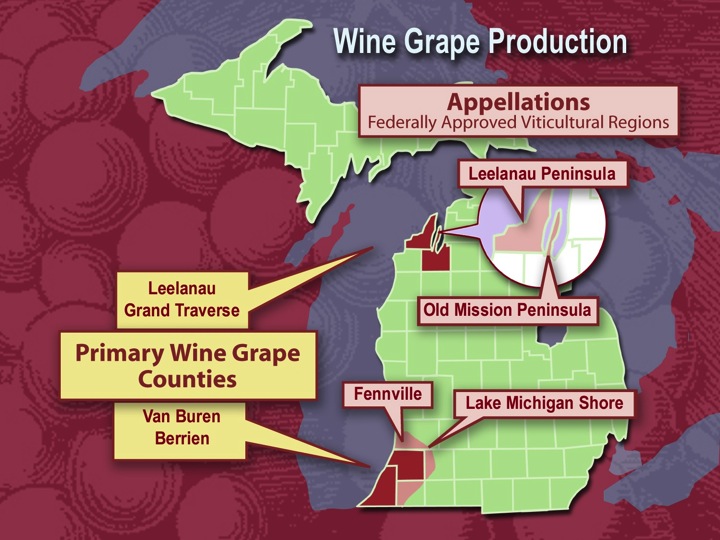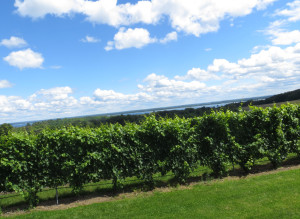Michigan AVA’s Create Their Own Character
 Michigan currently has four AVAs. AVA is an acronym for American Viticultural Area, a term used to define a particular grape growing region.
Michigan currently has four AVAs. AVA is an acronym for American Viticultural Area, a term used to define a particular grape growing region.
It’s similar to the term ‘appellation,” which is used in France to indicate a specific geographical area where grapes are grown. In order for a winery to put an AVA name on the label, 85% of the grapes used to make the wine must come from within the AVA’s borders.
Getting an area designated as an AVA is no easy task. The Alcohol and Tobacco Tax and Trade Bureau (TTB) is the governmental entity responsible for defining and administering AVAs throughout the United States. The requirements for establishing an AVA are arduous, bureaucratic, and time-consuming.
If you ask Dr. Gerald Perrone of Pleasantview Winery in Harbor Springs, MI, he’ll be more than happy to elaborate in excruciating detail the challenges of getting an area designated as an AVA. Dr. Perrone is spearheading efforts by numerous wineries in the northernmost part of Michigan’s Lower Peninsula to have a new AVA- “The Straits AVA”- certified by the TTB.
We’ll concentrate on Michigan’s AVAs that are already established. Two AVAs are in southwestern Michigan and two are located in northwestern Michigan. Using the Riesling grape as a control grape, a brief comparison of the effects that different AVAs have on wines produced from the Riesling grape will be examined.
Michigan’s oldest AVA is the Fennville AVA. Established in 1981, it’s the third oldest AVA in the entire country. Talk about Midwest winemaking ‘roots”- Michigan’s got them!
The Fenn Valley AVA was created by Fenn Valley Winery. The Fennville AVA’s 75,000 acres are contained entirely inside of the Lake Michigan Shore AVA, the Wolverine State’s largest AVA. (More about that AVA shortly.)
With Lake Michigan to the west, the Kalamazoo River to the north, a game preserve to the east, and the Black River on the south, the Fennville AVA benefits from the classic moderating effects of Lake Michigan. Fennville’s low-lying sandy soils produce some Rieslings that are quite ‘fruity” and softer than Rieslings from northern Michigan, Germany or New York.
The largest Michigan AVA is the Lake Michigan Shore AVA. Established in 1983 and consisting of 1,280,000 acres, this AVA wholly contains the Fennville AVA as a sub region. Geographical boundaries of the Lake Michigan Shore AVA are the Kalamazoo River to the north, then east approximately 45 miles inland to the Penn Central railroad line then south to the Michigan/Indiana state line and then west to Lake Michigan.
Naturally, the climate of this big AVA is extremely similar to that of the Fennville AVA. Soils of the Lake Michigan Shore AVA have glacial moraine characteristics typical of southwestern Michigan.
It’s critical to realize that Michigan AVAs climates are unique. Lake Michigan Shore AVA’s growing season can be two weeks longer than either the Leelanau Peninsula AVA or the Old Mission Peninsula AVA, which are farther north. A longer growing season facilitates longer ‘hang time” for the grapes. This extended time ensures that Rieslings from the Lake Michigan Shore frequently have greater ripeness and tropical fruit aromas than wines from the northern AVAs.
The scenic Leelanau Peninsula AVA is, simply, the Leelanau Peninsula! Encompassing 75,000 acres, it’s the same size as its southern cousin, the Fennville AVA. Michigan’s second AVA was established in 1982 by Bernie Rink, Bruce Simpson and Larry Mawby, all pioneers of the Michigan wine industry.
Bordered almost entirely by water, and containing glacial Lake Leelanau and other lakes as well, this AVA is perhaps the most famous of Michigan’s AVAs.
Projecting into Lake Michigan and Grand Traverse Bay, the ‘lake effect” moderates its climate enabling the vineyards to have approximately 145 frost-free days, a large number for land this far north. When the glaciers rolled through they deposited gravelly loam and sand on top of clay subsoil and the limestone and granite bedrock.
As in most northern AVAs, most vines face south to maximize the warmth of the sun. Leelanau Peninsula vineyards can be rocky, causing the vines to work for moisture. Rieslings from this AVA are refreshing, with aromas of apples and pears.
Michigan’s newest AVA, the Old Mission Peninsula AVA, was approved in 1987. This peninsula splits Grand Traverse Bay into western and eastern arms. The coolest of the four AVAs, Old Mission is just 19 miles long and only three miles wide at the widest point.
This slender configuration means that the ‘lake effect” is more pronounced here than anywhere in Michigan. While keeping the peninsula’s heat levels quite low, it usually prevents sudden temperature drops from freezing the grapes on the vines.
Old Mission Peninsula is the smallest of Michigan’s AVAs with only 19,200 acres. “OMP,” as locals affectionately call it, is virtually an exurb of Traverse City, but it’s one of the most scenic places on the Great Lakes. With the two arms of Grand Traverse Bay on either side, the Peninsula rises above a backdrop of deep, sparking turquoise water.

Brys Estate Winery’s vineyard with Grand Traverse Bay in the background, Old Mission Peninsula Michigan
These cool conditions and slow ripening facilitates ripe grapes with crisp, fresh varietal character. Soils here have more clay than in the three other AVAs. Floral aromas and pleasant acidity are hallmarks of Rieslings from this AVA.
All of Michigan’s AVAs are easily accessible with well-defined wine trails and signage. Each one has a unique character defined by its location in the ‘mitten” state. Yet all benefit from the ‘lake effect” of large bodies of water that enables the grapes to ripen more fully for a better wine. How many of them have you visited?
Next up, Charlie Edson from Bel Lago.
This article is sponsored by MI Wine Barrel, makers of durable and economic stainless steel wine barrels


